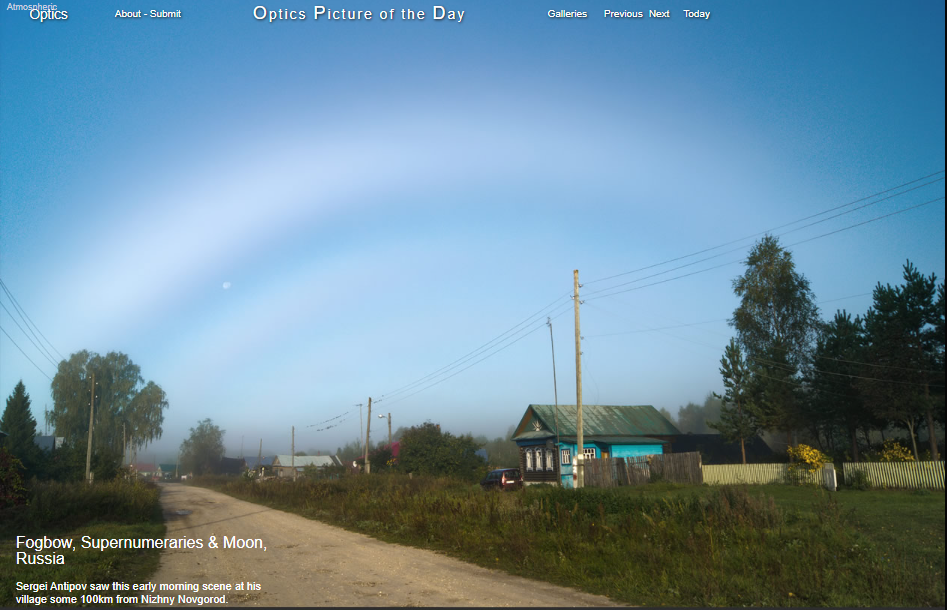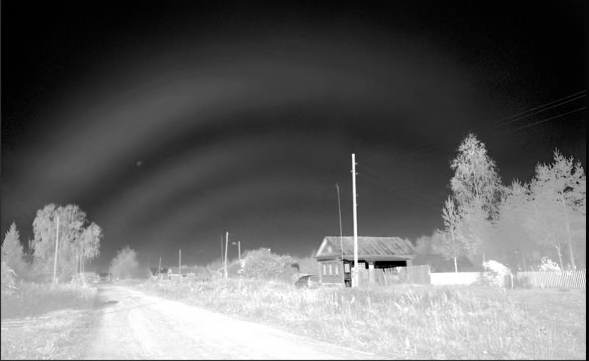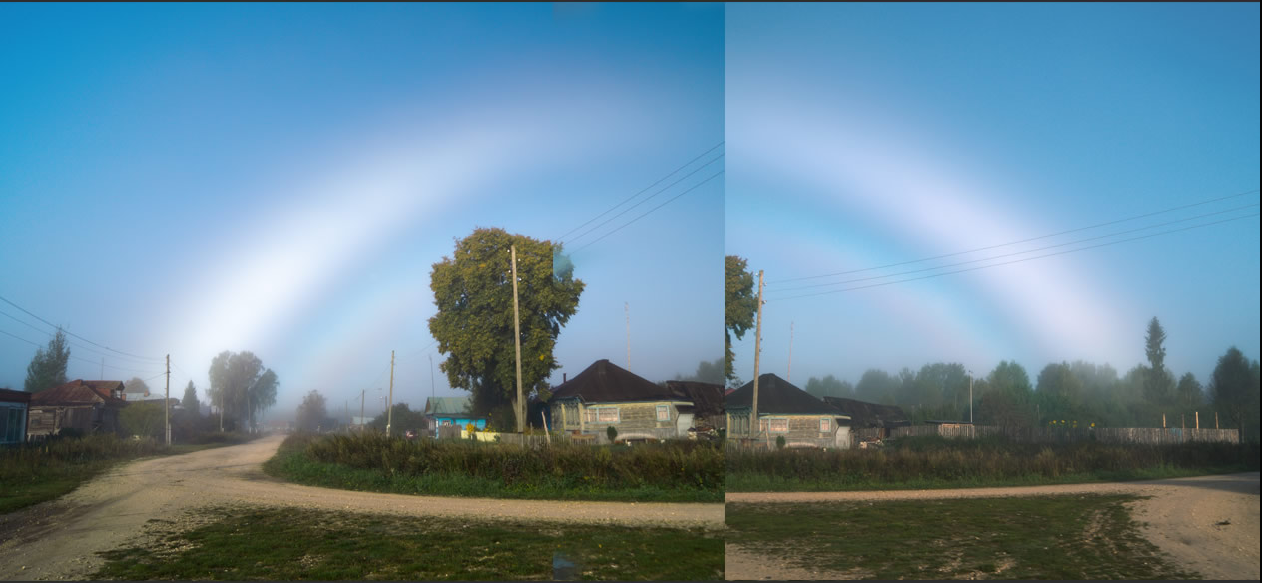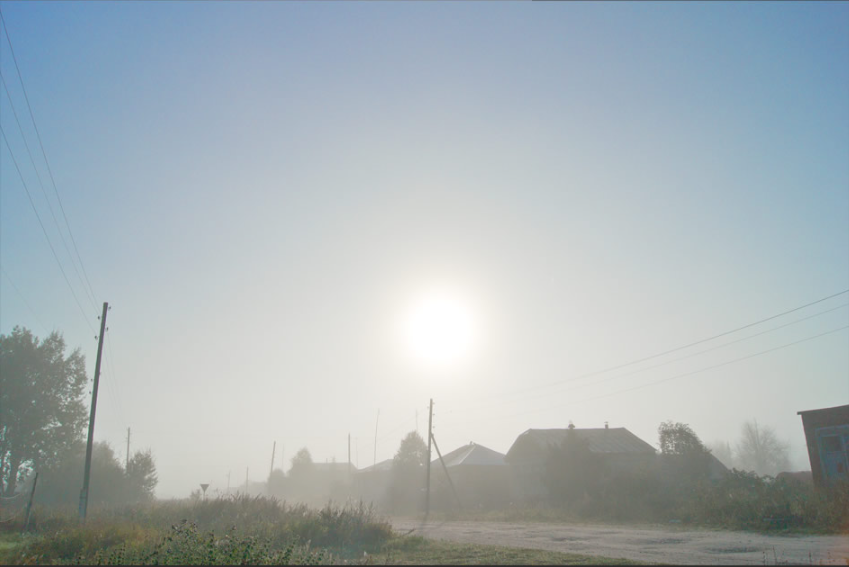Fogbow, Supernumeraries & Moon, Russia - OPOD
Fogbow, Supernumeraries & Moon, Russia - OPOD: Exploring the Enigmatic Beauty of Atmospheric Optics
Have you ever witnessed the ethereal dance of light in the atmosphere? Sergei Antipov, a resident of a village near Nizhny Novgorod in Russia, had the privilege of capturing a mesmerizing atmospheric phenomenon. On a chilly morning, with temperatures dropping to -1°C overnight, Antipov was greeted by a stunning fogbow as the sun's rays pierced through the mist. This captivating display of nature's artistry unfolded before his eyes, accompanied by the appearance of not one, but two supernumeraries within the primary arc of the fogbow.
The initial supernumerary was so striking that Antipov rushed indoors to retrieve his camera. To his delight, the LCD viewfinder revealed an additional supernumerary. These supplemental rainbows occur due to interference patterns caused by the diffraction of light as it interacts with water droplets in the fog. Antipov's photographic prowess allowed him to immortalize this magical moment, forever preserving the memory of his first encounter with a fogbow.
A notable feature of fogbows is their immense size, rivaling that of their more well-known counterpart, the rainbow. Unlike rainbows, which are characterized by distinct bands of colors, fogbows possess a broader appearance. This difference arises from variations in the size of water droplets suspended in the air. In the case of fogbows, mist droplets with a uniform size contribute to the clarity and definition of the supernumeraries. Conversely, a mixture of droplet sizes can lead to blurred and indistinct secondary rainbows.
The use of a polarizing filter on Antipov's camera lens resulted in a unique effect on the fogbow's visibility. While the filter enhanced the appearance of the supernumeraries, it also diminished the overall brightness of the bow. It is worth noting that both rainbows and fogbows exhibit strong polarization. Consequently, the application of a polarizing filter allows only a portion of the bow to be captured in a single image, enhancing specific features while sacrificing others.
For those fortunate enough to witness a fogbow, optimal conditions occur when a thin layer of fog or mist is illuminated by the radiant rays of a bright sun. This interplay of light, water droplets, and atmospheric conditions creates a spectacle that transcends the ordinary, transporting observers into a realm of enchantment. The ethereal beauty of fogbows captivates the imagination and reminds us of the hidden wonders that surround us in the natural world.
As we delve deeper into the intricacies of atmospheric optics, it is essential to acknowledge the impact of various factors on the appearance of these awe-inspiring phenomena. The size and uniformity of water droplets, the intensity and polarization of light, and the thickness of the fog or mist layer all contribute to the nuanced characteristics of fogbows. Each observation offers a unique opportunity to unravel the secrets of nature's canvas, inviting us to marvel at its ever-changing palette.
In conclusion, Sergei Antipov's encounter with a fogbow and its accompanying supernumeraries in Russia unveils the enigmatic beauty of atmospheric optics. Through his lens, we catch a glimpse of the intricate interplay between light and water droplets suspended in the air. Fogbows, with their broad arcs and captivating secondary rainbows, hold a mystique that continues to intrigue both scientists and admirers of natural wonders alike. Let us remain open to the unexpected and embrace the breathtaking displays that nature so generously bestows upon us.

Fogbow, Supernumeraries & Moon, Russia
Sergei Antipov saw this early morning scene at his village some 100km from Nizhny Novgorod.
"The temperature dropped to -1C overnight and had risen to 2C by 06:50 when the sun was bright and I saw this intense fogbow. Inside the primary arc the first supernumerary was visible. I ran indoors to get the camera and a second supernumerary was visible in its LCD viewfinder.
I always use a polarizing filter on the lens and so the rainbow in my picture has maximum brightness over only a part of its arc. In reality, the fogbow was complete.
The memory of my first fogbow is preserved in the photographs."
Note the diminutive Moon. Fogbows like rainbows are huge. Unlike rainbows they can be very broad.
All images ©Sergei Aleksandrovich Antipov

Right: A colour subtraction enhancement reveals 3 to 4 supernumeraries.
So many of them says that the mist droplets had a uniform size. The fogbow spacing changes with droplet size and a mixture of different sizes therefore gives blurred and indistinct supernumeraries.
The faintness of the bow at right is a consequence of the polarizing filter. Fogbows (and rainbows) are strongly polarized. A filter enhances supernumeraries but at a cost of making only part of the bow visible in any single image.


Fogbows are best when the fog/mist layer is thin and a bright sun shines through.
Note: this article has been automatically converted from the old site and may not appear as intended. You can find the original article here.
Reference Atmospheric Optics
If you use any of the definitions, information, or data presented on Atmospheric Optics, please copy the link or reference below to properly credit us as the reference source. Thank you!
-
<a href="https://atoptics.co.uk/blog/fogbow-supernumeraries-moon-russia-opod/">Fogbow, Supernumeraries & Moon, Russia - OPOD</a>
-
"Fogbow, Supernumeraries & Moon, Russia - OPOD". Atmospheric Optics. Accessed on November 26, 2024. https://atoptics.co.uk/blog/fogbow-supernumeraries-moon-russia-opod/.
-
"Fogbow, Supernumeraries & Moon, Russia - OPOD". Atmospheric Optics, https://atoptics.co.uk/blog/fogbow-supernumeraries-moon-russia-opod/. Accessed 26 November, 2024
-
Fogbow, Supernumeraries & Moon, Russia - OPOD. Atmospheric Optics. Retrieved from https://atoptics.co.uk/blog/fogbow-supernumeraries-moon-russia-opod/.